Bata brand known for well-made and well-priced footwear, clothing and accessories, was founded in 1894 in Zlín, Moravia by Tomáš Baťa, his brother Antonín and his sister Anna. Its headquarters is located in Lausanne, Switzerland. Bata succeeded in becoming one of Europe’s leading shoe manufacturers in just a few decades, due to smart entrepreneurship and competitive pricing. In the early 1930s, the company was present in Switzerland, Germany, England, France, Yugoslavia, Poland, India and the Netherlands. By 1960, Bata employed about 42,000 employees owned thousands of companies and factories in almost every continent. It was one of the few manufacturers to sell its products all over the world. In 1970, Bata Industrials was founded to meet a specific demand for footwear for professionals.
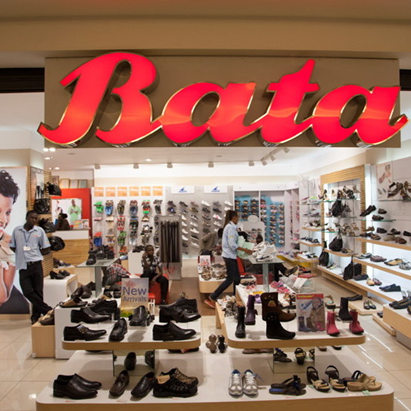
Since then, Bata Industrials has evolved to become a designer, producer, and marketer of safety footwear and socks, targeting the professional end user markets. At present, Bata Industrials is one of the world’s largest manufacturers of this type of footwear. It operates four business units worldwide- Bata Europe, Bata Emerging Markets, Bata Branded Business and Bata North America.
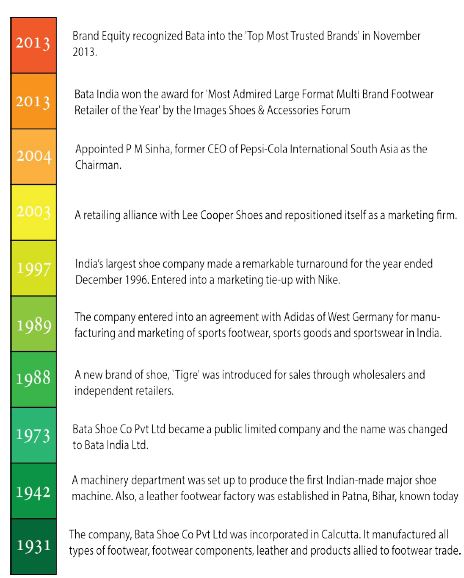
Bata World-Wide
Bata has recorded its presence in more 70 countries with over 5000 stores. The 28 production units are spread across 18 countries. Bata serves more than 1 million customers every day.
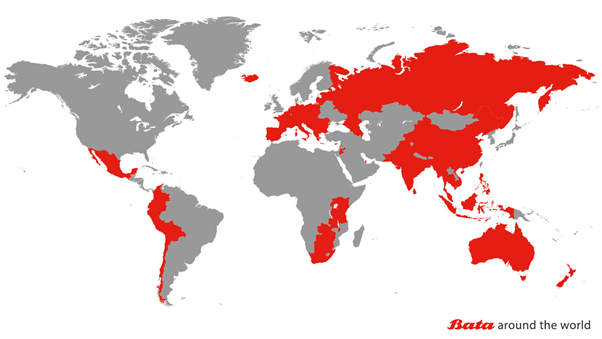
Bata Enters India
1931– The company, Bata Shoe Co Pvt Ltd was incorporated in Calcutta. It manufactured all types of footwear, footwear components, leather and products allied to footwear trade.
1942– A machinery department was set up to produce the first Indian-made major shoe machine. Also, a leather footwear factory was established in Patna, Bihar, known today as Bataganj.
1973– Bata Shoe Co Pvt Ltd became a public limited company and the name was changed to Bata India Ltd.
1988– A new brand of shoe, `Tigre’ was introduced for sales through wholesalers and independent retailers.
1989– The company entered into an agreement with Adidas of West Germany for manufacturing and marketing of sports footwear, sports goods and sportswear in India.
1997– India’s largest shoe company made a remarkable turnaround for the year ended December 1996. Entered into a marketing tie-up with Nike.
2003– A retailing alliance with Lee Cooper Shoes and repositioned itself as a marketing firm.
2004– Appointed P M Sinha, former CEO of Pepsi-Cola International South Asia as the Chairman.
2013– Bata India won the award for ‘Most Admired Large Format Multi Brand Footwear Retailer of the Year’ by the Images Shoes & Accessories Forum – 2013. Brand Equity recognized Bata into the ‘Top Most Trusted Brands’ in November 2013.
Product Portfolio
Bata’s vision is “To make great shoes accessible to everyone!” It offers footwear for all age groups. It has over 2500 styles of footwear & accessories. Bata’s portfolio includes Boots, Formal Shoes, Casual Shoes, Sandals, Bags, Belts and Wallets for men; Closed Shoes, Sandals, Head Over Heels, Clutches, Scarves, Handbags for women & school shoes for kids.
Competitors
The footwear market in India is highly unorganized with many local brands still dominating the market. Paragon & Relaxo are the brands with lower product prices & targeting the masses. Brands like Nike, Adidas and Reebok are the most famous in the metro cities and urban India. In the formal shoe market, Red Tape & Lee Cooper are leading brands. Puma is the fastest growing shoe brand in India.
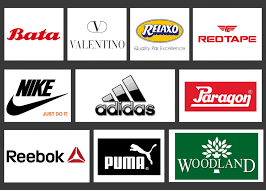
Advertising
Vintage BATA Ads
In 1929, Bata ads were simple and straight forward. It contained little more than two shoes with their price mentioned along with the name of the company. By 1935, not much was changed with the ads being simple and direct connecting with the consumers. Some changes were made which were socially acceptable like the depiction of more personal moments, such as a woman in her bedroom sleeping on a comfortable pair of Bata slippers. These ads appeared in ladies magazines at times. After the Second World War, advertising undergone major changes and Bata kept up with it. In 1948, Bata came up with a Swiss ad featuring a kitten popping out of the top of a boot. In 1960, Bata exploded the global market, adding many sales outlets and factories all over the world. In the 1960s the ad industry shifted its focus to more youthful markets. Bata incorporated photography into its ads to attract the younger generations.
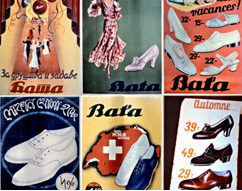
During 1970s, Bata was at the forefront of fashion both in terms of product styles and presentation of its ads of chunky, platform shoes and psychedelic colours. In 1980s, Bata’s focus was to promote lifestyle branded products and came up with a series of campaigns like the almost futuristic, high-tech look of Marie Claire and Power Athletics ads appealing to aerobics fans of the era.
For a few years, Bata did not come up with any effective promotional campaigns. They did not advertise for a long time. Considering the rising competition and behaviour of customers it was necessary for Bata to get into advertising. Advertising was needed to create top of the mind awareness not only to attract new customers, but also to retain their old customers. For example, a Bata customer might want to buy Relaxo slipper because of the advertisements or the models used to display it. Bata had to put in more on repeated exposure and take advantage of various mediums to do the same.
Marketing Campaigns
“Where Life Meets Style”- Spring-Summer 2014 Marketing Campaign
Bata India launched its new marketing campaign “Where Life Meets Style” in March 2014 for its entire range of footwear, bags, glasses and accessories. The campaign featured a 360-degree multimedia integration of TV commercials, cinema, print, radio, and innovative outdoor, promotions, events and digital platforms. The T.V commercial aired across channels had been shot to capture a slice-of-life situation in the lives of people through the focus on footwear. It used a unique technique of depicting real life moments by showing the actions only from the knee down. It included a group of students eagerly looking at their exam results, colleagues watching a cricket match and young girls enjoying their ‘day out’. The film showcases the leading brands in their latest styles. The new campaign emphasizes fashion and comfort of Bata shoes. It is a remarkable milestone in Bata’s journey.

“Have we met”- Campaign for shoe-lovers
Bata tied up with Digital agency Section to launch a digital campaign ‘Have we met’ around the theme of nostalgia. It includes a microsite to extend online dedicated engagement and reach to reconnect with younger customers. It also has a short film that enacts the reunion of two lost friends through a pair of shoes. Section developed a digital platform for users to share a personal message to a friend and select a pair of their preferred Bata shoe. It helps individuals relive memories and reconnect with one another.
Bata Club
Bata Club is a loyalty program which offers great rewards and privileges. Customers need to register their names & phone numbers to become a member. With every purchase at Bata stores, points equal to bill amount get added to the account which you can redeem at next purchase with Bata. Few other benefits include new registration bonus, Birthday bonus, Member’s sale day & Special products in store at exclusive prices for members. The Bata club has approx. 6.7 million members & is growing rapidly.
Repositioning
Bata had initially positioned itself as a family store for all footwear and related products. Bata became a need brand as it positioned itself as providing products catering to the needs of the middle class sections of the society. Bata was loved by everyone in the family. The brand had something for every member of the household.
It came up with new brands like Marie Claire, Hush Puppies and North Star. Bata was known as a manufacturing company which produced footwear and sold them. It wanted to change its image from a manufacturing company to a marketing company. It wanted to be placed in the market as a fashion conscious and lifestyle brand. It decided to become more visible in shopping malls and create a shop-in-shop experience in multi-branded stores. The company also introduced international brands like Scholl, Marie Claire, Bubble gummers, POWER, and North Star.
During the last few years, Bata has focused on the modernisation of factories & manufacturing processes. Bata stores are being renovated to provide world class store ambience & delightful shopping experience. Bata plans to open 30 new retail stores, 30 new franchise stores & 5 destination stores with kid’s playing area, food court etc. every year.
To leverage the exponential growth of e-commerce Bata started with e-commerce division. Along with online business, e-commerce division focuses on tie-ups with reputed companies & banks like HDFC, Samsung, Spice Jet, State Bank of India etc. to increase the brand awareness & customer database. The launch of new Bata mobile application has strengthened its e-commerce business. Bata blog is a style inspiration for the young audience & a channel for online surveys & feedbacks.
Online Presence
Apart from its vast offline presence, Bata is present online through its website bata.in and has its own delivery channel ‘Bata Home’. It has various categories ranging from women’s section to men’s, section for kids and different brands such as Angry Birds, Hush Puppies, marie claire, Sunshine and many more. The company has tie-ups with e-commerce sites such as Snapdeal, Jabong, Junglee and Rediff. In 2014-2015, its multi-channel business has performed very well and is expected to continue the same with its products and service. To facilitate the shopping ease, M-wallet service has been launched. The company website http://www.bata.in has been re-launched where customers can now their favourite products on social media. The company also came with ‘Click and Collect’ where customers can shop online and get their products delivered to the local Bata shops, this would also help bring more customers to their shops.
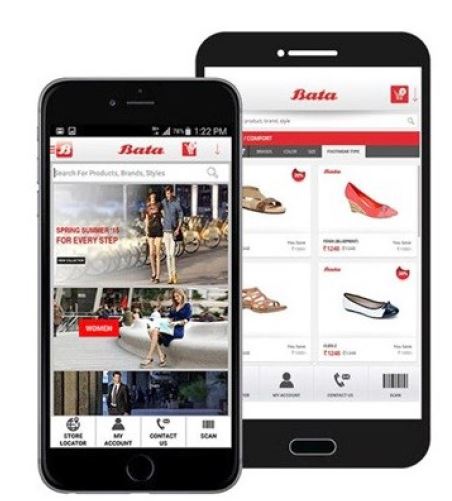
Social Initiatives
Bata launched ‘Bata Children’s Program’ (BCP) in 2010 to help disabled children in the communities where Bata is present. It has adopted schools in their areas of operations as a part of this initiative. It has carried more than 100 initiatives in 22 countries. Computer labs are set up at BCP schools in Bataganj and Gurgaon and were able to reach out to 150 girls. It also came up with Each One Teach One campaign where volunteers dedicate four to six hours every month to teach both curricular extra-curricular activities to underprivileged children. BCP came up with Each One Feed One campaign with The Akshaypatra Foundation, where the employees were requested to donate Rs 750 and with this, they provided meals to 200 underprivileged children. Other initiatives include Book Wall Campaign, Donation of fans in schools, Health check- ups, Infrastructure improvement in BCP schools.
STP Analysis
Segmentation:
Segmentation involves finding out what kinds of consumers with different needs exist.
Based on Demographics
The demographic factors are age, Income, gender & occupation. Bata offers products mainly to men & woman above the age of 14, with limited products for school kids.
Based on psychographic factors
Personal Activities like hobbies, social events (marathon), sports, shopping and Personal interests like fashion, styles are considered in psychographic factors. Bata being the mother brand covers all these segments in their portfolio.
Target:
Target customer of Bata includes Price conscious middle-class families, youth looking for affordable & trendy products. It targets all the age groups & has something for every member of the family, i.e. men, women & kids.
Position:
Positioning is done in order to locate the brand in the minds of the customers. The positioning is done with respect to the brand and product portfolio. Bata positions itself as a brand that offers comfortable footwear & stylish accessories for the entire family at an affordable price.
SWOT Analysis
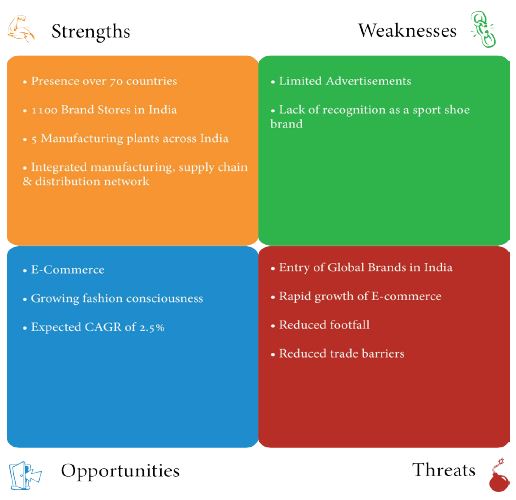
The government of India has now allowed 100% Foreign Direct Investment (FDI) in the footwear manufacturing industry, the proposed reduction in excise duty on rubber sheets for soles & heels from 12.5& to 6%. Such steps by the government are beneficial for sector growth. Rapid change in lifestyle creates huge potential for footwear industry & Bata India with its relentless efforts continues to be the market leader.
References
Ukessays, bata.in, Bata India Ltd. Annual report 2015-16
world.bata.com, marketing-interactive.com


